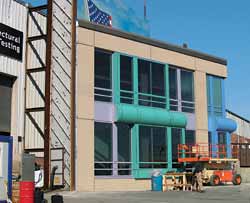High-Performing Envelopes Demand Know-How
Learning Objectives:
- Discuss recent national efforts to improve envelope performance.
- Explain the role of the National Institute of Building Sciences.
- Describe the purpose of building commissioning.
Credits:
We demand a great deal from the building envelope-the skin that shelters us from the outside world. For starters, it must protect us from rain and snow, provide appropriate amounts of sunlight and fresh air, retain interior warmth in the winter and resist exterior heat in the summer, all the while exuding an aesthetic that suits owner and public alike. To this intricate mix, add the tantalizing promises of new materials, products, and systems, and ever more stringent energy, security, and other requirements, and the job of designing a building's outer shell becomes very complicated indeed. So complicated, in fact, that some fear architects may be losing their grip on this most visible building component. "The exterior of the building is how architects identify ourselves-it's our calling card, yet we are no longer in control of it if we don't know the building science and the technology necessary to design high-performing envelopes," says Richard Keleher, AIA, a technical-quality and drawing-review consultant in Concord, Massachusetts, and former director of building-envelope technology at The Stubbins Associates. He predicts that, if things continue as they have in recent years, envelope consultants may one day be dictating the look of our buildings.
Fortunately, three recent national efforts to improve the performance of building envelopes are laudable steps toward remedying the current situation. These include the publication of the Building Envelope Design Guide, a comprehensive resource for the design and construction of institutional and office buildings; the Exterior Enclosure Technical Requirements for the Commissioning Process, which outlines a step-by-step process to ensure that a new envelope will function as intended; and the formation of building enclosure councils, which establish a forum within which practicing architects throughout the country can begin to learn the fundamentals of building science and discover regionally appropriate solutions.
|
Although all three efforts evolved separately, the complementary programs have coalesced under the auspices of the National Institute of Building Sciences (NIBS), in Washington, D.C., a nonprofit, nongovernmental organization established by the U.S. Congress in 1974 to serve as a bridge between government and the private sector in order to improve the quality and efficiency of construction in this country. Among many other functions, NIBS disseminates technical information and helps introduce appropriate technologies into the building process. Referring to the advancement of high-performance envelopes, NIBS vice president Earle W. Kennett observes, "No one discipline figures this into their domain because of the multidisciplinary nature of the work." Nonetheless, to achieve high-quality enclosures, it is critical that the different disciplines interact and learn from each other. As an experienced intermediary among the varied facets of the design and construction industry, NIBS was well positioned to take on these new, inherently multidisciplinary initiatives.










